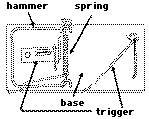
Biologist Michael
Behe defined Irreducible Complexity as a system of component parts,
in which if any single component is removed, the system ceases to function.
His
example is a simple mousetrap, with four components: 
1. a base,The mouse is caught between the base and the hammer, and held by the pressure of the spring. The trigger holds it open until the mouse is in place, then released to capture the mouse. In Behe's description (from which this picture is adapted) he has subdivided the trigger into two parts, which changes the description somewhat, but not the basic function.
2. a hammer,
3. a spring to force them together, and
4. a trigger to hold them apart.
In his book, Behe goes on to describe a very different mousetrap, but with the same four components: a box inverted over the ground, with one end held up by a stick tied to a string. The ground is the base, the stick is the trigger, and the spring function is provided by gravity. Again all four components form an IC system.
Here's a typical perversion of IC, which I received from an otherwise intelligent university professor:
I feel that complexity can usually be analysed, in which case it is not irreducable.His specialty is computers, and we write incredibly complex programs, which continue to astound me in that they actually work (sometimes). We teach programmers a variation on the classic military strategy: Divide and Conquer. Divide the problem into smaller problems, and solve each of them by the same method. When the pieces become small enough, each one can be solved directly by one of a small number of known algorithms or problem-solving tools. This is the only way we can hope to manage the complexity of large projects. Perhaps this person is simply too busy with his computational agenda to address the question of IC.
Or perhaps he is in denial. There are IC problems in computer programming. It is not that D&C cannot be applied to them, for it can. We can separately analyze the hammer and the spring -- and that is a necessary part of constructing them -- but the mousetrap cannot work if either of them is missing.
Another critic tried to construct a mousetrap out of a single piece of metal, contrived so that each of the four parts of the trap was a different part of the same piece of metal, as if thus we had eliminated the parts. Not at all! He did separately identify four parts; the fact that they were all formed in the same physical piece of metal is irrelevant. The trap only works because all four parts are present and functional.
Yet another critic recognizes the nature of IC, and tries instead to
deny that IC occurs in natural systems. He goes to great lengths to show
that the hemoglobin clot sequence, which is one of Behe's examples, is
different and simpler in some animals. That does not disprove that Behe's
example is a case of IC, but only that a different IC system is used elsewhere
in nature. In the mousetrap example above, I have reduced Behe's original
five components to four, but it cannot be further reduced. Nevertheless,
even if Behe is mistaken about the irreducibility of the clot sequence,
his numerous other examples remain; this critic did not successfully demolish
all of them. It is only necessary for a single instance of IC to occur
in nature to prove Intelligent Design.